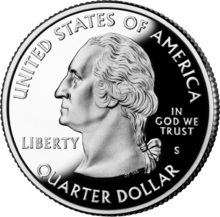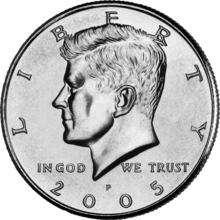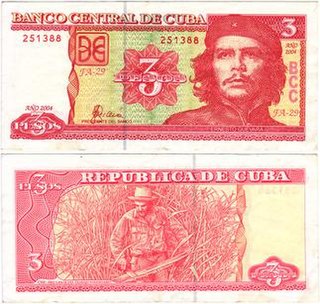
Several presidents of the United States have appeared on currency. The President of the United States has appeared on official banknotes, coins for circulation, and commemorative coins in the United States, the Confederate States of America, the Philippine Islands, the Commonwealth of the Philippines and around the world.

The president of the United States (POTUS) is the head of state and head of government of the United States of America. The president directs the executive branch of the federal government and is the commander-in-chief of the United States Armed Forces.

The United States of America (USA), commonly known as the United States or America, is a country comprising 50 states, a federal district, five major self-governing territories, and various possessions. At 3.8 million square miles, the United States is the world's third or fourth largest country by total area and is slightly smaller than the entire continent of Europe's 3.9 million square miles. With a population of over 327 million people, the U.S. is the third most populous country. The capital is Washington, D.C., and the largest city by population is New York City. Forty-eight states and the capital's federal district are contiguous in North America between Canada and Mexico. The State of Alaska is in the northwest corner of North America, bordered by Canada to the east and across the Bering Strait from Russia to the west. The State of Hawaii is an archipelago in the mid-Pacific Ocean. The U.S. territories are scattered about the Pacific Ocean and the Caribbean Sea, stretching across nine official time zones. The extremely diverse geography, climate, and wildlife of the United States make it one of the world's 17 megadiverse countries.

The Confederate States of America, commonly referred to as the Confederacy, was an unrecognized country in North America that existed from 1861 to 1865. The Confederacy was originally formed by seven secessionist slave-holding states—South Carolina, Mississippi, Florida, Alabama, Georgia, Louisiana, and Texas—in the Lower South region of the United States, whose economy was heavily dependent upon agriculture, particularly cotton, and a plantation system that relied upon the labor of African-American slaves.
Contents
- United States
- George Washington
- John Adams
- Thomas Jefferson
- James Madison
- James Monroe
- John Quincy Adams
- Andrew Jackson
- Martin Van Buren
- William H. Harrison
- John Tyler
- James K. Polk
- Zachary Taylor
- Millard Fillmore
- Franklin Pierce
- James Buchanan
- Abraham Lincoln
- Andrew Johnson
- Ulysses S. Grant
- Rutherford B. Hayes
- James A. Garfield
- Chester A. Arthur
- Grover Cleveland
- Benjamin Harrison
- William McKinley
- Theodore Roosevelt
- William Howard Taft
- Woodrow Wilson
- Warren G. Harding
- Calvin Coolidge
- Herbert Hoover
- Franklin D. Roosevelt
- Harry S. Truman
- Dwight D. Eisenhower
- John F. Kennedy
- Lyndon B. Johnson
- Richard Nixon
- Gerald Ford
- Ronald Reagan
- George H. W. Bush
- Presidential dollar coin series
- Confederate States of America
- Andrew Jackson 2
- George Washington 2
- Philippine Islands, Commonwealth of the Philippines, Republic of the Philippines
- William McKinley 2
- Ronald Reagan 2
- Franklin D. Roosevelt 2
- George Washington 3
- U.S. Presidential appearances on other coins and currency around the world
- The Bahamas
- Cook Islands
- Cuba
- Isle of Man
- Liberia
- Marshall Islands
- Niue
- Paraguay
- Turks and Caicos Islands
- United Arab Emirates
- Western Samoa
- See also
- References
- Bibliography
- External links



























































